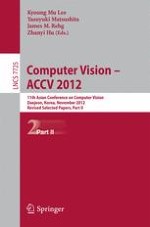2013 | OriginalPaper | Buchkapitel
Hierarchical Space Tiling for Scene Modeling
verfasst von : Shuo Wang, Yizhou Wang, Song-Chun Zhu
Erschienen in: Computer Vision – ACCV 2012
Verlag: Springer Berlin Heidelberg
Aktivieren Sie unsere intelligente Suche, um passende Fachinhalte oder Patente zu finden.
Wählen Sie Textabschnitte aus um mit Künstlicher Intelligenz passenden Patente zu finden. powered by
Markieren Sie Textabschnitte, um KI-gestützt weitere passende Inhalte zu finden. powered by
A typical scene category,
e.g.,
street and beach, contains an enormous number (
e.g.,
in the order of 10
4
to 10
5
) of distinct scene configurations that are composed of objects and regions of varying shapes in different layouts. A well-known representation that can effectively address such complexity is the family of compositional models; however, learning the structures of the hierarchical compositional models remains a challenging task in vision. The objective of this paper is to present an efficient method for learning such models from a set of scene configurations. We start with an over-complete representation called
Hierarchical Space Tiling (HST)
, which quantizes the huge and continuous scene configuration space in an And-Or tree (AOT). This hierarchical AOT can generate a combinatorial number of configurations (in the order of 10
31
) through a small dictionary of elements. Then we estimate the HST/AOT model through a learning-by-parsing strategy, which iteratively updates the HST/AOT parameters while constructing the optimal parse trees for each training configuration. Finally we prune out the branches with zero or low probability to obtain a much smaller HST/AOT. The HST quantization allows us to transfer the challenging
structure-learning
problem to a tractable
parameter-learning
problem. We evaluate the representation in three aspects. (i) Coding efficiency. We show the learned representation can approximate valid configurations with less errors using smaller number of primitives than other popular representations. (ii) Semantic power of learning. The learned representation is less ambiguous in parsing configuration and has semantically meaningful inner concepts. It captures both the diversity and the frequency (prior) of the scene configurations. (iii) Scene classification. The model is not only fully generative but also yields discriminative scene classification performance which outperforms the state-of-the-art methods.
